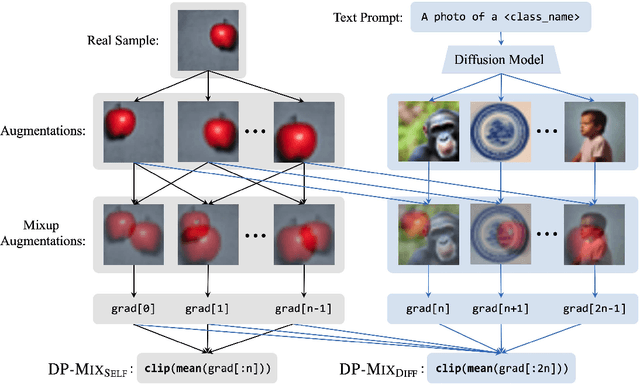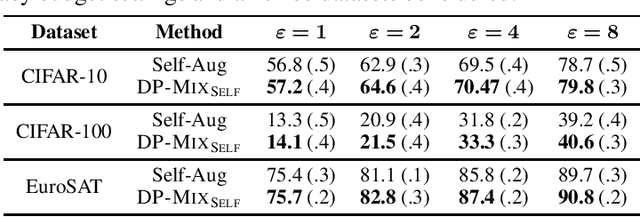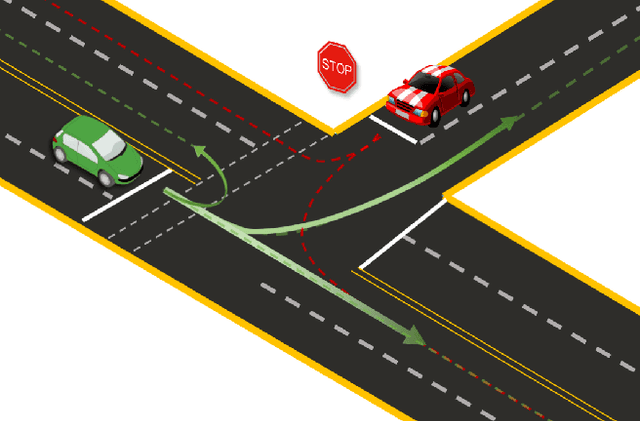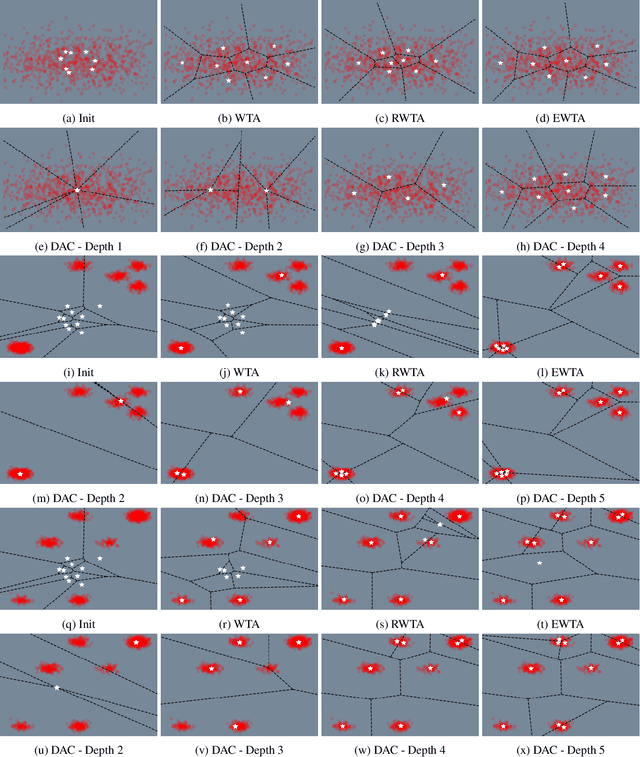Francesco Pittaluga
LANGTRAJ: Diffusion Model and Dataset for Language-Conditioned Trajectory Simulation
Apr 15, 2025Abstract:Evaluating autonomous vehicles with controllability enables scalable testing in counterfactual or structured settings, enhancing both efficiency and safety. We introduce LangTraj, a language-conditioned scene-diffusion model that simulates the joint behavior of all agents in traffic scenarios. By conditioning on natural language inputs, LangTraj provides flexible and intuitive control over interactive behaviors, generating nuanced and realistic scenarios. Unlike prior approaches that depend on domain-specific guidance functions, LangTraj incorporates language conditioning during training, facilitating more intuitive traffic simulation control. We propose a novel closed-loop training strategy for diffusion models, explicitly tailored to enhance stability and realism during closed-loop simulation. To support language-conditioned simulation, we develop Inter-Drive, a large-scale dataset with diverse and interactive labels for training language-conditioned diffusion models. Our dataset is built upon a scalable pipeline for annotating agent-agent interactions and single-agent behaviors, ensuring rich and varied supervision. Validated on the Waymo Motion Dataset, LangTraj demonstrates strong performance in realism, language controllability, and language-conditioned safety-critical simulation, establishing a new paradigm for flexible and scalable autonomous vehicle testing.
Controllable Safety-Critical Closed-loop Traffic Simulation via Guided Diffusion
Dec 31, 2023Abstract:Evaluating the performance of autonomous vehicle planning algorithms necessitates simulating long-tail traffic scenarios. Traditional methods for generating safety-critical scenarios often fall short in realism and controllability. Furthermore, these techniques generally neglect the dynamics of agent interactions. To mitigate these limitations, we introduce a novel closed-loop simulation framework rooted in guided diffusion models. Our approach yields two distinct advantages: 1) the generation of realistic long-tail scenarios that closely emulate real-world conditions, and 2) enhanced controllability, enabling more comprehensive and interactive evaluations. We achieve this through novel guidance objectives that enhance road progress while lowering collision and off-road rates. We develop a novel approach to simulate safety-critical scenarios through an adversarial term in the denoising process, which allows the adversarial agent to challenge a planner with plausible maneuvers, while all agents in the scene exhibit reactive and realistic behaviors. We validate our framework empirically using the NuScenes dataset, demonstrating improvements in both realism and controllability. These findings affirm that guided diffusion models provide a robust and versatile foundation for safety-critical, interactive traffic simulation, extending their utility across the broader landscape of autonomous driving. For additional resources and demonstrations, visit our project page at https://safe-sim.github.io.
LLM-Assist: Enhancing Closed-Loop Planning with Language-Based Reasoning
Dec 30, 2023Abstract:Although planning is a crucial component of the autonomous driving stack, researchers have yet to develop robust planning algorithms that are capable of safely handling the diverse range of possible driving scenarios. Learning-based planners suffer from overfitting and poor long-tail performance. On the other hand, rule-based planners generalize well, but might fail to handle scenarios that require complex driving maneuvers. To address these limitations, we investigate the possibility of leveraging the common-sense reasoning capabilities of Large Language Models (LLMs) such as GPT4 and Llama2 to generate plans for self-driving vehicles. In particular, we develop a novel hybrid planner that leverages a conventional rule-based planner in conjunction with an LLM-based planner. Guided by commonsense reasoning abilities of LLMs, our approach navigates complex scenarios which existing planners struggle with, produces well-reasoned outputs while also remaining grounded through working alongside the rule-based approach. Through extensive evaluation on the nuPlan benchmark, we achieve state-of-the-art performance, outperforming all existing pure learning- and rule-based methods across most metrics. Our code will be available at https://llmassist.github.io.
OpEnCam: Lensless Optical Encryption Camera
Dec 02, 2023Abstract:Lensless cameras multiplex the incoming light before it is recorded by the sensor. This ability to multiplex the incoming light has led to the development of ultra-thin, high-speed, and single-shot 3D imagers. Recently, there have been various attempts at demonstrating another useful aspect of lensless cameras - their ability to preserve the privacy of a scene by capturing encrypted measurements. However, existing lensless camera designs suffer numerous inherent privacy vulnerabilities. To demonstrate this, we develop the first comprehensive attack model for encryption cameras, and propose OpEnCam -- a novel lensless OPtical ENcryption CAmera design that overcomes these vulnerabilities. OpEnCam encrypts the incoming light before capturing it using the modulating ability of optical masks. Recovery of the original scene from an OpEnCam measurement is possible only if one has access to the camera's encryption key, defined by the unique optical elements of each camera. Our OpEnCam design introduces two major improvements over existing lensless camera designs - (a) the use of two co-axially located optical masks, one stuck to the sensor and the other a few millimeters above the sensor and (b) the design of mask patterns, which are derived heuristically from signal processing ideas. We show, through experiments, that OpEnCam is robust against a range of attack types while still maintaining the imaging capabilities of existing lensless cameras. We validate the efficacy of OpEnCam using simulated and real data. Finally, we built and tested a prototype in the lab for proof-of-concept.
DP-Mix: Mixup-based Data Augmentation for Differentially Private Learning
Nov 02, 2023



Abstract:Data augmentation techniques, such as simple image transformations and combinations, are highly effective at improving the generalization of computer vision models, especially when training data is limited. However, such techniques are fundamentally incompatible with differentially private learning approaches, due to the latter's built-in assumption that each training image's contribution to the learned model is bounded. In this paper, we investigate why naive applications of multi-sample data augmentation techniques, such as mixup, fail to achieve good performance and propose two novel data augmentation techniques specifically designed for the constraints of differentially private learning. Our first technique, DP-Mix_Self, achieves SoTA classification performance across a range of datasets and settings by performing mixup on self-augmented data. Our second technique, DP-Mix_Diff, further improves performance by incorporating synthetic data from a pre-trained diffusion model into the mixup process. We open-source the code at https://github.com/wenxuan-Bao/DP-Mix.
LDP-Feat: Image Features with Local Differential Privacy
Aug 22, 2023Abstract:Modern computer vision services often require users to share raw feature descriptors with an untrusted server. This presents an inherent privacy risk, as raw descriptors may be used to recover the source images from which they were extracted. To address this issue, researchers recently proposed privatizing image features by embedding them within an affine subspace containing the original feature as well as adversarial feature samples. In this paper, we propose two novel inversion attacks to show that it is possible to (approximately) recover the original image features from these embeddings, allowing us to recover privacy-critical image content. In light of such successes and the lack of theoretical privacy guarantees afforded by existing visual privacy methods, we further propose the first method to privatize image features via local differential privacy, which, unlike prior approaches, provides a guaranteed bound for privacy leakage regardless of the strength of the attacks. In addition, our method yields strong performance in visual localization as a downstream task while enjoying the privacy guarantee.
Divide-and-Conquer for Lane-Aware Diverse Trajectory Prediction
Apr 16, 2021



Abstract:Trajectory prediction is a safety-critical tool for autonomous vehicles to plan and execute actions. Our work addresses two key challenges in trajectory prediction, learning multimodal outputs, and better predictions by imposing constraints using driving knowledge. Recent methods have achieved strong performances using Multi-Choice Learning objectives like winner-takes-all (WTA) or best-of-many. But the impact of those methods in learning diverse hypotheses is under-studied as such objectives highly depend on their initialization for diversity. As our first contribution, we propose a novel Divide-And-Conquer (DAC) approach that acts as a better initialization technique to WTA objective, resulting in diverse outputs without any spurious modes. Our second contribution is a novel trajectory prediction framework called ALAN that uses existing lane centerlines as anchors to provide trajectories constrained to the input lanes. Our framework provides multi-agent trajectory outputs in a forward pass by capturing interactions through hypercolumn descriptors and incorporating scene information in the form of rasterized images and per-agent lane anchors. Experiments on synthetic and real data show that the proposed DAC captures the data distribution better compare to other WTA family of objectives. Further, we show that our ALAN approach provides on par or better performance with SOTA methods evaluated on Nuscenes urban driving benchmark.
Voting-based Approaches For Differentially Private Federated Learning
Oct 09, 2020



Abstract:While federated learning (FL) enables distributed agents to collaboratively train a centralized model without sharing data with each other, it fails to protect users against inference attacks that mine private information from the centralized model. Thus, facilitating federated learning methods with differential privacy (DPFL) becomes attractive. Existing algorithms based on privately aggregating clipped gradients require many rounds of communication, which may not converge, and cannot scale up to large-capacity models due to explicit dimension-dependence in its added noise. In this paper, we adopt the knowledge transfer model of private learning pioneered by Papernot et al. (2017; 2018) and extend their algorithm PATE, as well as the recent alternative PrivateKNN (Zhu et al., 2020) to the federated learning setting. The key difference is that our method privately aggregates the labels from the agents in a voting scheme, instead of aggregating the gradients, hence avoiding the dimension dependence and achieving significant savings in communication cost. Theoretically, we show that when the margins of the voting scores are large, the agents enjoy exponentially higher accuracy and stronger (data-dependent) differential privacy guarantees on both agent-level and instance-level. Extensive experiments show that our approach significantly improves the privacy-utility trade-off over the current state-of-the-art in DPFL.
SMART: Simultaneous Multi-Agent Recurrent Trajectory Prediction
Jul 26, 2020



Abstract:We propose advances that address two key challenges in future trajectory prediction: (i) multimodality in both training data and predictions and (ii) constant time inference regardless of number of agents. Existing trajectory predictions are fundamentally limited by lack of diversity in training data, which is difficult to acquire with sufficient coverage of possible modes. Our first contribution is an automatic method to simulate diverse trajectories in the top-view. It uses pre-existing datasets and maps as initialization, mines existing trajectories to represent realistic driving behaviors and uses a multi-agent vehicle dynamics simulator to generate diverse new trajectories that cover various modes and are consistent with scene layout constraints. Our second contribution is a novel method that generates diverse predictions while accounting for scene semantics and multi-agent interactions, with constant-time inference independent of the number of agents. We propose a convLSTM with novel state pooling operations and losses to predict scene-consistent states of multiple agents in a single forward pass, along with a CVAE for diversity. We validate our proposed multi-agent trajectory prediction approach by training and testing on the proposed simulated dataset and existing real datasets of traffic scenes. In both cases, our approach outperforms SOTA methods by a large margin, highlighting the benefits of both our diverse dataset simulation and constant-time diverse trajectory prediction methods.
A MEMS-based Foveating LIDAR to enable Real-time Adaptive Depth Sensing
Mar 21, 2020



Abstract:Most active depth sensors sample their visual field using a fixed pattern, decided by accuracy, speed and cost trade-offs, rather than scene content. However, a number of recent works have demonstrated that adapting measurement patterns to scene content can offer significantly better trade-offs. We propose a hardware LIDAR design that allows flexible real-time measurements according to dynamically specified measurement patterns. Our flexible depth sensor design consists of a controllable scanning LIDAR that can foveate, or increase resolution in regions of interest, and that can fully leverage the power of adaptive depth sensing. We describe our optical setup and calibration, which enables fast sparse depth measurements using a scanning MEMS (micro-electro mechanical) mirror. We validate the efficacy of our prototype LIDAR design by testing on over 75 static and dynamic scenes spanning a range of environments. We also show CNN-based depth-map completion of sparse measurements obtained by our sensor. Our experiments show that our sensor can realize adaptive depth sensing systems.
 Add to Chrome
Add to Chrome Add to Firefox
Add to Firefox Add to Edge
Add to Edge